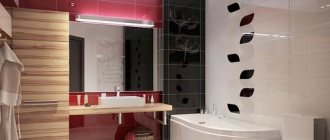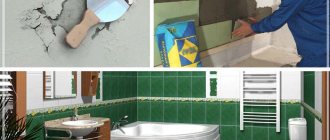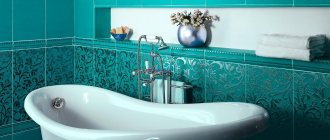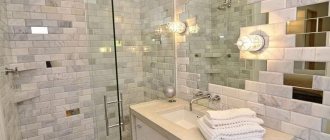The Japanese style of interior design brings calm and sophistication, a sense of unity with nature and an aesthetic that helps restore vitality and emotional energy. That is why it is an ideal option for furnishing a bathroom. After all, the most important thing in this environment is not only physical, but also mental comfort. The main features of Japanese style are simplicity and conciseness. This means that you can decorate the bathroom interior in the traditions of the Land of the Rising Sun with minimal effort and money, without involving specialists in the field of renovation.
Features of a Japanese bathroom
Japanese homes are characterized by a small area, which is due to the culture and history of the people. It was in Japan that minimalism originated, as in conditions of cramped people learned to make do with little. The bathroom was also furnished in a minimalist style. Instead of the familiar full-length bathtubs, they used wooden barrels or special wooden containers that were built into the floor.
We return here every evening, after a hard day of work, to absorb the fullness of the relaxing and rejuvenating effect.
Today, real wooden barrels are still part of the Japanese bathhouse, and bathtubs in the floor are often used in modern interiors.
This room can not only save you from the endless noise and bustle, but also give you a boost of energy for the whole day.
There is nothing superfluous in a Japanese bathroom. Here a person performs hygiene procedures while taking a break from the working day, and therefore nothing should distract him.
Exquisite Japanese style bathroom.
Most often, the room is covered with wooden or bamboo panels, but today you can use materials that imitate them, for example, laminate. The color scheme is in warm, natural tones, diluted with red and black.
The beauty and splendor of Japanese interior lies in its minimalism and simplicity.
Important! To create an authentic environment, use all shades of brown in your design, avoid color contrasts that make the design hectic, distracting, or colorful.
Japanese bathroom layout
The Japanese rarely see a combined bathroom in an apartment. The classic bathroom in Japan is separated from the toilet. When planning an oriental design in your own home, think of a way to separate two rooms, perhaps using a symbolic partition or screen. The separation of the bathroom is associated with the culture of hygiene that prevails in Japan. Here, taking a bath is an entire art that has been created over the course of a century.
Ergonomic design is able to harmoniously combine natural motifs and modern conveniences.
The specifics of the culture determine the layout of the room itself. A traditional Japanese-style bathroom features a shower and a deep, square bathtub made of wood that is built into the floor. This design allows you to retain heat for a long time. To minimize heat loss, half of the bath was covered with a lid.
Japanese style inspiration.
Modern rooms look different - they often have a shower stall and a countertop with a sink - an echo of ancient times, when a vessel with water was simply placed on the table.
If you have enough space, a bathroom can fit comfortably into the overall design of your home.
In small apartments you have to choose between a shower and a bathtub, and to reproduce the Japanese style, it is recommended to choose the second option.
Pay attention to the use of a ladder as a stylish and fashionable accessory for storing towels.
Bamboo trunks in decoration
Bamboo trunks will help diversify the design of the room. With their help you can create a real exotic forest. Such an interior solution is practical and beautiful, since it can become an interior partition and divide the room into functional zones.
Options for decorating a room with trunks Source www.vmconcept.com
It is recommended to place bamboo trunks of any thickness not only vertically, but also horizontally. Using such a design, you will be able to focus attention on various interior details.
Bamboo in the interior, used for decorative columns, bar counters and other surfaces, will allow you to change the design of the room. The use of trunks will help:
- Symbolically delimit the area. To do this, you need to place several bamboo trunks nearby.
- Fill stair railings . It is worth considering that such a solution is unsafe for children.
From the remains of plant trunks you can create a floor vase or flowerpot and other interior decorative elements.
Decorating a room with bamboo Source dizainvfoto.ru
See also: Catalog of projects of small houses with a terrace.
Japanese bathroom design
The main feature that distinguishes an eastern interior from a western one is minimalism, which here does not look cold and uninhabited, but, on the contrary, seems warm and cozy. The secret is not so much in the layout as in the choice of design materials. The Japanese use natural stone, wood, and bamboo to achieve a feeling of warmth and unity with nature.
An excellent choice would be to use natural wood in the design.
Design Features:
- laconic lines;
- predominance of geometric shapes;
- lack of pretentiousness and decorative elements;
- daylight;
- use of natural materials;
- warm colors.
If the main purpose of this room in your home is a place for relaxation and beauty treatments, then why not decorate it in the style of a SPA salon.
The key element in the room will be the Japanese bathtub, which differs from the European one not only in its location and shape, but also in its placement.
A glass shower cabin, wooden benches and a huge number of terry towels will be relevant.
When developing a drawing of a room, be sure to plan a podium into which a traditional bath will be built. Without this element, the design is unlikely to be authentic, and therefore a small podium should be provided, which is usually placed in the back of the room.
Japanese-style room with an oval pebbled bathtub and black granite
For wall coverings, use natural wood panels, brown tiles, stone or laminate. Combinations of brown and white, as well as their combinations with black, look organic. All three colors can be used harmoniously within the design of one room. Black tiles are ideal for floors, wood siding for walls, and white for plumbing fixtures.
To achieve results, it is enough to adhere to several general trends.
It is better to choose wall-mounted furniture and plumbing fixtures - such models look modern and are suitable for Japanese design. A sink on a wooden countertop, a hanging cabinet and a bathtub built into the floor - there is nothing superfluous in Japanese design.
Ultra-minimalism in the Japanese style is truly amazing.
In a large room, you can use a screen to zone the space. In a small one, it is advisable to do without even a shower curtain, which will look too European.
Just take a look, it looks just great!
Accessories and decor are also recommended to be used in a large room, as they can overload a small room.
There is no need to try to dilute the design with bright decor; give preference to calm tones when it comes to the bathroom.
Note! If it is not possible to organize a real Japanese bath, then purchase a model that closely resembles a traditional ofuro.
Types of Japanese baths
Today there are two main types of baths in Japan: furako and ofuro. They differ in shape and purpose. A separate item includes a traditional wooden bath, which is essentially a type of ofuro.
As you know, the main rule of Japanese design is strict minimalism.
Furaco
Many people know that in Japan, bathtubs were made of wood. This tradition appeared in ancient times and is still relevant today. The bathtub can be round, square, rectangular or oval.
If the bathroom is large enough, a traditional Japanese bathtub would be an excellent solution.
Furaco is a large barrel in which it is customary to bathe in hot water. Furaco in its original form is used in baths and fonts. It can be installed in private houses, cottages, and dachas. Furaco is unlikely to look organic in an apartment due to its size and water heating features.
As an option, you can use cedar - similar properties are complemented by a wonderful aroma.
Ofuro
Today, the term ofuro is used to describe any bathtub in the Japanese or similar style. Initially, ofuro meant a wooden bathtub built into the floor, into which one immersed oneself up to the shoulders. Today, ofuro is made not only from wood, but also from other materials, including modern, technological ones. The only feature that has survived to this day is that the bathtub has a square shape, less often rectangular, unlike furaco, which is made in a round or oval shape.
Ofuro is a wooden Japanese bathtub made from hinoki wood.
Today you can easily find a suitable ofuro model to install in an apartment or private house. This term refers to any round, streamlined high bathtub or low, square bathtub that is installed on a podium.
Any of the constituent design elements matters when creating a composition.
Wooden
Originally, the Japanese wooden bathtub was made from hinoki wood, which is characterized by antibacterial properties, resistance to mold and rot, and is also insect-resistant.
In the Japanese style, to achieve harmony, various calm tones are used, which please the eye and create balance.
Due to these properties, hinoki were used to make fonts. Some manufacturers produce wooden bathtubs that fit perfectly into the Japanese style of an apartment or house.
Important! A wooden bathtub will not only decorate your interior, but will help improve your health and calm your nervous system.
A Japanese-style bathroom should have simple lines and shapes and a neutral color scheme.
Ofuro
This is what cedar boxes are called; one of them uses sawdust, the other uses pebbles; this system is necessary for one of the important stages of work. This design implies a rectangular ofuro shape; the box is almost always made from solid cedar or oak. The typical heating method is bottom heating. Electric heating devices are widely used in modern products. As for the sizes, they should be such that you can lie in the ofuro at full height. At least 40 kg of sawdust is placed inside. Heating, depending on the size of the bath, is provided using an electrical installation with a power of 1500 - 6000 W.
Bathtub placement tips
In a traditional Japanese interior, the bathtub is a key component of the decor, and therefore it is placed in the most visible place. There are several placement methods:
- at the far wall on the podium;
- in the middle of the room (suitable for large rooms);
- in the corner (opposite you can install a shower);
- near the window.
Modern apartments, as a rule, have small bathrooms, but if you have the desire and imagination, it will not be difficult to decorate the room beautifully and stylishly.
The podium can also be installed in the center, which will also look stylish and in the spirit of Japan.
Japanese style is characterized by harmony and naturalness of shapes and lines. It encourages relaxation and relaxation. In a bathroom designed in an oriental style, you can truly enjoy peace and relaxation.
Some useful information and figures
Some manufacturers give a 90 guarantee! years for its products. Below are some useful tips, nuances and some information needed to make this deadline become a reality.
- When choosing a tile, consider its moisture resistance group. Occasional condensation on the walls is one thing, constant contact with water is quite another. Of the eight existing categories of water absorption, we are only interested in two: AI and BI, they absorb up to 3% moisture. The extreme case, AIIa or BIIa, is up to 6%. See the instructions on the packaging or ask the sellers. No less important is the resistance class of the tiles to cleaning chemicals. For household use, tiles of the following classes are suitable: GA - ordinary household chemicals, or GLA - compositions with an acid concentration of up to 3% are acceptable.
- Wear resistance class, not applicable to walls. Typically, it is classified as floor tiles. For domestic use, they are usually limited to one of the first three classes. If you set it and forget it, take class III: PEI3/750 or PEI3/1500.
Regardless of the cost of the tiles, although you should understand that a low price will definitely affect the quality, you need to carefully carry out the process of installing bamboo tiles.
Particular attention should be paid to the prevention of fungal formations. It should begin by treating the walls with special compounds even before laying the tiles. Be sure to take care of normal ventilation and waterproofing in the bathroom.
Bamboo tiles laid with skillful hands will never tire of you. Every time you enter the bathroom, you will look at the pattern on the walls in a new way, relaxing and filling your inner world with the harmony of nature.









